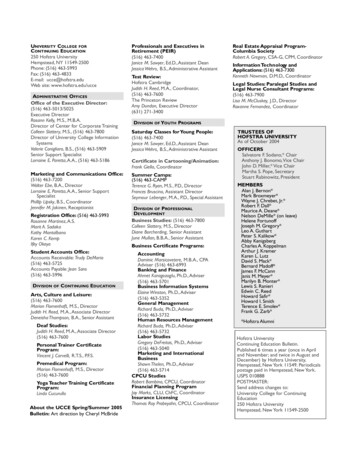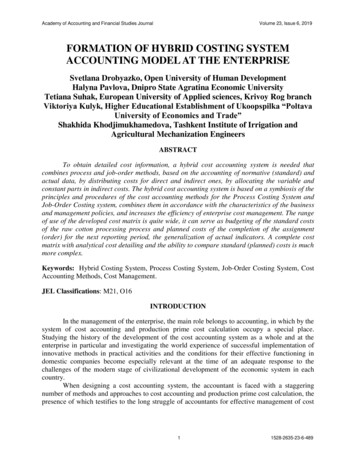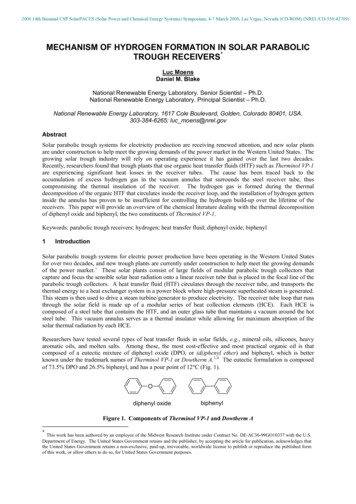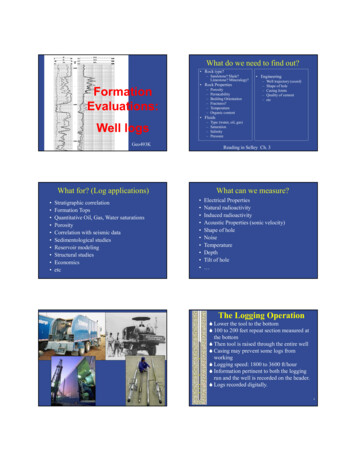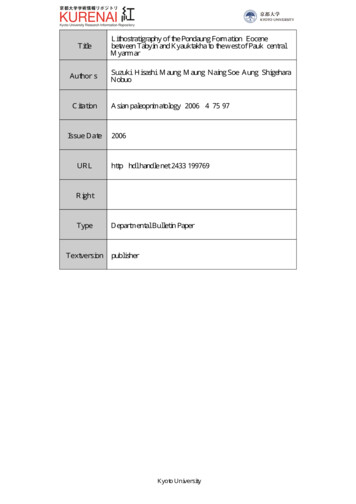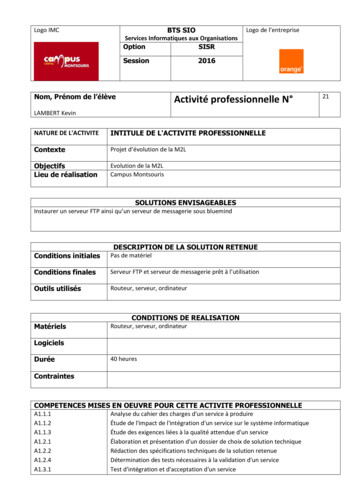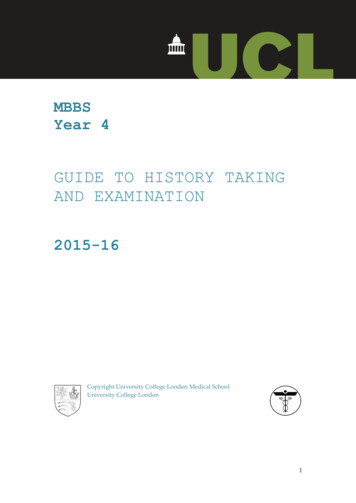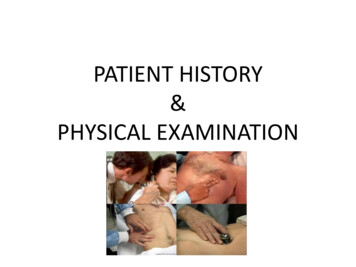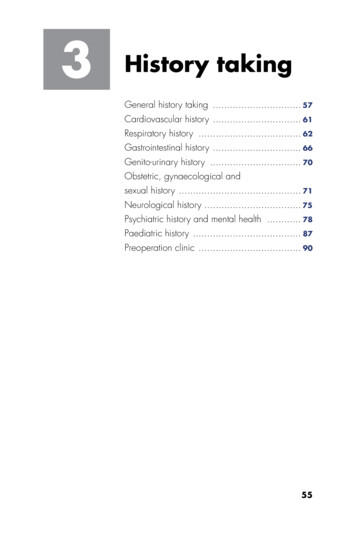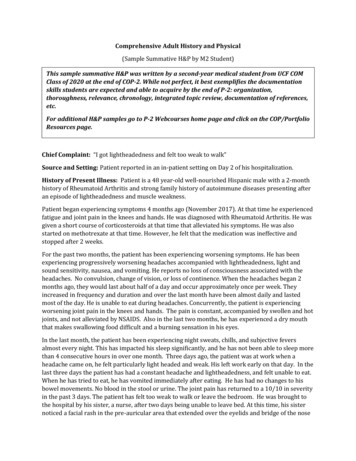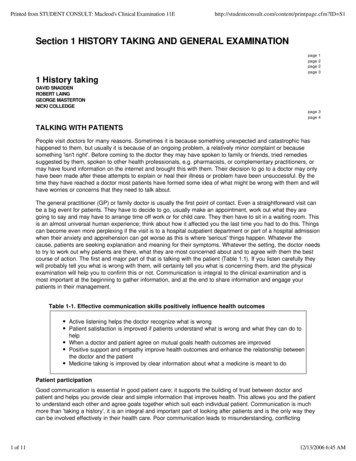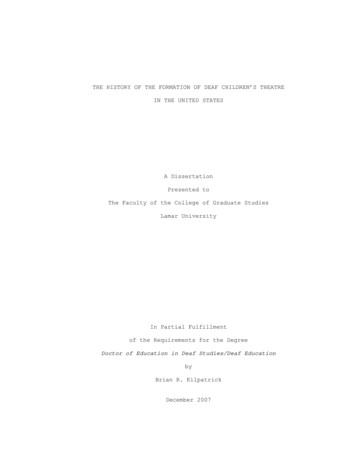
Transcription
THE HISTORY OF THE FORMATION OF DEAF CHILDREN’S THEATREIN THE UNITED STATESA DissertationPresented toThe Faculty of the College of Graduate StudiesLamar UniversityIn Partial Fulfillmentof the Requirements for the DegreeDoctor of Education in Deaf Studies/Deaf EducationbyBrian R. KilpatrickDecember 2007
THE HISTORY OF THE FORMATION OF DEAF CHILDREN’S THEATREIN THE UNITED STATESBRIAN R. KILPATRICKApproved:Jean F. AndrewsSupervising ProfessorAnne GentryCommittee MemberGabriel MartinCommittee MemberGabriel MartinChair, Department of CommunicationDisorders and Deaf EducationLee ThompsonCommittee MemberRuss SchultzDean, College ofFine Arts and CommunicationSidney BergerCommittee MemberOney FitzpatrickInterim Dean, College of Graduate Studies
2007 by Brian R. KilpatrickNo part of this work can be reproduced without permission except asindicated by the “Fair Use” clause in the copyright law. Passages,images, or ideas taken from this work must be properly credited in anywritten or published materials.
ABSTRACTTHE HISTORY OF THE FORMATION OF DEAF CHILDREN’S THEATREIN THE UNITED STATESBRIAN R. KILPATRICKThis dissertation explores the history of Deaf Children’s Theatrein America, by collecting and recording its formation and developmentfrom archival materials, from on-site interviews, and from documentspublished during the late twentieth century.This study investigates the ways in which theatre becameaccessible to deaf people through apposite legislation and describesseveral forms of accessibility services for deaf and hearing audiencesat theatrical performances.The evolution of theatre leading to the formation of Deaf Theatreand, later, to the nascence of Deaf Children’s Theatre is exploredwithin the larger social and political context of the American culture.The case history of each of the six Deaf Children’s Theatregroups established variously at Hartford, Connecticut; Bethesda,Maryland; Seattle, Washington; Boston, Massachusetts; Chicago,Illinois; and Houston, Texas is presented to portray the particulardevelopment of Theatre Arts for deaf children in America.The six Deaf Children’s Theatre groups presented in this studyhave had different approaches to complementing and completing deafchildren’s education. Suggested future research is directed to thepotential future impact of drama on deaf children’s languagedevelopment and also to various avenues of support for Deaf Theatre inits battle for survival.
ACKNOWLEDGEMENTSI would like to express my appreciation to the wonderful Deaf andhearing people working in the field of Theatre Arts whom I interviewedfor this research.My special gratitude is extended to my old, yet always young andspecial friends from Fairmount Theatre of the Deaf (now calledCleveland Signstage), to the National Theatre of the Deaf’s summerschool students and staff, and to all the other professional actors andactresses who shared their archival materials and personal belongings,along with their experience and perspectives concerning the impact ofthe theatre world on contemporary society and on deaf children’seducation.I would also like to give sincere thanks for the Federal fundingreceived by the Doctoral Program in Deaf Studies/Education at LamarUniversity. By providing scholarships it has allowed for continuousproductive research.I owe special thanks to my late mother and to my recently latefather for their support, encouragement, and belief in my doctoralstudies.Also, many thanks to my Deaf friends, to my friends in the Deafcommunity and in the ASL/Interpreter Training programs, to outsiders,to non-deaf signers, and to others who have contributed to thecompletion of this dissertation.Most of all, I want to express my thousand-fold gratitude to mywife, Jacqueline, who has lovingly and faithfully believed in me andencouraged me, making possible the completion of this project.iii
CONTENTSTABLES. xiILLUSTRATIONS. xiiGLOSSARY. xiiiChapter. 11.INTRODUCTION . 1Who Are Deaf Children and Youth? . 3Two Perspectives on Deafness . 3Medical/Audiological Model. 3Cultural/Linguistic Model. 4Accessibility . 6Deaf Theatre and the Two Models . 6Deaf Studies . 8Educational Benefits of Deaf Theatre . 9Research and Organization . 10Historical Research Methods . 10Procedures . 15Organization . 16Endnotes for Chapter 1 . 172.ACCESSIBILITY FOR DEAF INDIVIDUALS IN THEATRE ARTS . 19Introduction . 19A Brief Description of the Origins and Evolution of Theatre 20Motion Pictures . 22Legal Provisions for Accessibility . 24Public Law 85-905 . 25Section 504 of the Rehabilitation Act . 26Americans with Disabilities Act (ADA) of 1990 . 27iv
Television Decoder Circuitry Act of 1990 . 28Telecommunications Act of 1996 . 29Implementing Accessibility Provisions in Theatre . 30English Captioning . 31Open Captioning. 32Closed Captioning. 32Communication Access Real Time Translation (CART). 33Amplification Systems . 35Theatrical Arts Interpreting . 37Interpreting for Deaf-Blind Persons. 40Theatre Interpreting for Children versus Adults. 45Performance Issues. 46Interpreter Organizations and Theatre . 47American Sign Language Interpreting. 49Challenges of Translating Plays Into ASL. 54Shadow Interpreting. 56Deaf Audience Preference. 59Performing Arts Interpreter Certification. 61A Comparison of Accessibility Options . 63Conclusion . 67Endnotes for Chapter 2 . 693.THE PRIDE AND TREASURE OF THE DEAF COMMUNITY: DEAF THEATRE . 76ASL Storytelling . 76Art-Sign . 77Deaf Literary Societies . 81Deaf Clubs . 82Literary Nights at Gallaudet . 82Deaf Clubs in the United States . 84v
Churches . 85Theatre of the Deaf . 86Meaning of Theatre . 86Deaf Theatre and Sign Language Theatre . 88Deaf Playwrights and Deaf Poets . 89University Deaf Theatre . 91Gallaudet University. 91National Technical Institute for the Deaf. 93Community Deaf Theatre . 94History. 94Deaf Actors. 102Deaf Children’s Theatre . 104Conclusion . 109Endnotes for Chapter 3 . 1114.LITTLE THEATRE OF THE DEAF . 118History of NTD . 118Beginnings and Organization . 122List of Plays and Workshops . 123Participants and Audiences . 124Kinds of Skills Taught . 124Conversations with Actors and Participants . 125Benefits of Theater for Deaf Children . 126Summary . 128Endnotes for Chapter 4 . 1305.INTERNATIONAL CENTER ON DEAFNESS AND THE ARTS (ICODA) . 133Beginnings and Organization . 134List of Plays and Workshops . 141Participants and Audiences . 141vi
Kinds of Skills Taught . 144Conversations with Actors and Participants . 147Summary . 148Endnotes for Chapter 5 . 1506.IMAGINATION STAGE . 153Beginnings and Organization . 153List of Plays and Workshops . 159Participants and Audiences . 160Kinds of Skills Taught . 161Conversations with Actors and Participants . 164Summary . 164Endnotes for Chapter 6 . 1657.ILLUMINATIONS ARTS . 168Beginnings and Organization . 168List of Plays and Workshops . 176Participants and Audiences . 181Kinds of Skills Taught . 182Conversations with Actors and Participants . 185Summary . 186Endnotes for Chapter 7 . 1888.SEATTLE CHILDREN’S THEATRE . 191Beginnings and Organization . 191List of Plays and Workshops . 195Participants and Audiences . 195Kinds of Skills Taught . 197Conversations with Actors and Participants . 199Summary . 201Endnotes for Chapter 8 . 203vii
9.PAH! DEAF YOUTH THEATRE . 206Beginnings and Organization . 206List of Plays and Workshops . 211Participants and Audiences . 214Kinds of Skills Taught . 215Conversations with Actors and Participants . 218Summary . 219Endnotes for Chapter 9 . 22210. CONCLUSION . 226BIBLIOGRAPHY. 234Appendix. 2571.TIMELINE OF THE HISTORY OF DEAF THEATRE . 257Timeline of the History of Deaf Theatre in General . 2571860s - 1900s . 2571920s . 257Early 1930s . 257Middle 1930s . 2581940s . 2581950s . 2581960s . 2581970s . 2591980s . 2591990s . 260Defunct Deaf Theatre Groups . 260Timeline of the Deaf Children’s Theatre . 2611970s . 2611980s . 2611990s . 261viii
2000s . 261Defunct Deaf Children’s Theatre Groups . 2612.CHRONOLOGY OF THEATRICAL INTERPRETING ARTS . 262Timeline of the History of Theatrical Interpreting . 2621930s . 2621960s . 2621970s . 2621980s . 2631990s . 2633.PRODUCTION HISTORY . 264National Theatre of the Deaf . 264Little Theatre of the Deaf . 266International Center on Deafness and the Arts . 267Imagination Stage . 269Illuminations Arts . 270Seattle Children’s Theatre . 284PAH! Deaf Youth Theatre . 2854.QUESTIONNAIRE FOR THEATRE DIRECTORS . 286The History of Theatre for Deaf Children in the United States 286Directory of the Six Deaf Children’s Theatre Groups . 2895.INTERVIEWS . 292Endnotes for Appendix 5 . 3086.DEAF PLAYWRIGHTS . 3091910s . 3091950s . 3091960s . 3091970s . 3091980s . 310ix
1990s . 3122000s . 313Endnotes for Appendix 6 . 314BIOGRAPHICAL NOTE. 315x
TABLESTable1. Number of D/deaf and Hearing Staff Interviewed at Each of the DeafChildren’s Theatre Groups. . 122. Number of D/deaf and Hearing Staff Interviewed at VariousTheatrical Events. . 13xi
ILLUSTRATIONSFigure1. Locations of Deaf Children’s Theatre Groups in the United States. 142. Access Symbols and Terminology. . 303. Speaker Identification in CART Open Captioning. . 314. Open Captioning Scenes. . 345. FM Assistive Device. . 356. Infrared Hearing Enhancement System by Phonic Ear. . 367. Lightweight Infrared Earphone. . 368. Seating Options for Interpreters for the Deaf-Blind. . 449. Interpreter Placement for the Deaf-Blind with Close-Vision. . 4410. Interpreter Placement for the Deaf-Blind using Tactile Signing. . 4411. Platform Interpreter Placement. . 5012. Platform Interpreting Scenes. . 5113. Sightline Interpreter Placement. . 5214. Zoned Interpreter Placement. . 5215. Zoned Interpreting Scene. . 5316. Shadow Interpreting Scenes. . 5817. Conversational ASL Rendition by Dorothy Miles. . 7918. Art-Sign Rendition by Louie Fant. . 79xii
GLOSSARYAccessibility. The modification of information, architecture, devices,or methods to allow easier access by people with disabilities.Examples include providing sign-language interpreters for apoetry reading, building an accessible ramp for a theatre stage,audio-describing a film, and/or providing technical aids foraccess to a computer.American Sign Language (ASL). The major language used by the AmericanDeaf population. Its medium is visual through hand movements andfacial expressions rather than aural. It has its own phonology,morphology, semantics, syntax, and pragmatics, just like anyother language.American Sign Language Consultant. American Sign Language Consultants(alternative terms: American Sign Language Coach and Sign Master)have knowledge about theatre and sign-language translation. Theymake sure that the interpreters’ appearance, the lighting onthem, and their positioning by the stage are all appropriate.They study the play, watch several shows with the interpreterspracticing the translations, and provide feedback.American Sign Language Gloss. Individual signs are labeled or namedusing a common convention in the field of American Sign Languagecalled glossing. An English word in all capital letters is thename or label for the sign. The gloss of a sign will representthe sign’s meaning. The sign could be translated to English usingthe word or words in the gloss.xiii
American Sign Language Interpreted Performances. Designatedperformances where interpretation is provided for the deaf andhard-of-hearing. Seating for each American Sign Languageinterpreted performance is located in the orchestra, house left.A synopsis is available for deaf patrons at the performance.American Sign Language (ASL) Literature. A body of stories, legends,poems, riddles, humor, and other genres told in American SignLanguage that has been passed on from one generation to anotherby culturally Deaf people. In addition, American Sign Languageliterature is not English literature that has been translatedinto American Sign Language. It arises from the thoughts,emotions, and experiences of culturally Deaf people. AmericanSign Language literature exists in two forms: real-time and realspace production, and on video storage media.Art-Sign. Artistic forms of signing. The structure of American SignLanguage can be artistically transformed to convey ideas in amanner other than through straightforward signs for communicationpurposes. These forms are storytelling (A-Z stories, numericalstories, classifier stories), drama, poetry, and so on. Artisticforms of signing have played an important role in Deaf cultureand history.ASL Narratives. The storyteller is signing his own thoughts, emotions,and experiences. The stories can be mischievous, success-related,scary, historical, fictional, or romantic.xiv
Assistive Listening Devices. Hearing enhancement systems using FMradio-waves transmission or infrared transmission technologies.Audio-Described Performance. A carefully timed, live narration of thevisual aspects of a performance. It is broadcast via a radiotransmitter to patrons who wear a single headphone receiver,enabling them to hear both the on-stage dialogue and thedescriber’s narration.Captioning. Subtitles reflecting the content of the spoken ordescriptive material. Closed Captioning of a video or filmprogram superimpose text over video for the benefit of deaf andhard-of-hearing viewers. Closed captions are hidden (encoded) asa data within the video signal and must be decoded to be visible.Captions are designed to convey
received by the Doctoral Program in Deaf Studies/Education at Lamar University. By providing scholarships it has allowed for continuous productive research. I owe special thanks to my late mother and to my recently late father for their support, encourage
